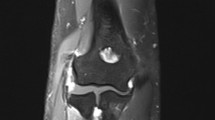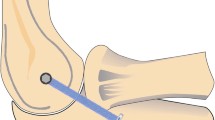Abstract
Purpose
Simple elbow dislocations are accompanied with lateral ulnar collateral ligament ruptures. For persisting instability, surgery is indicated to prevent chronic posterolateral rotatory instability. After lateral collateral ligament (LCL) complex repair the repair is protected by temporary immobilization, limited range of motion and hinged bracing. Internal bracing is an operative alternative augmenting the LCL repair using non-absorbable suture tapes. However, the stability of LCL repair with and without additional augmentation remains unclear. The hypothesis was that LCL repair with additional suture tape augmentation would improve load to failure. Secondary goal of this study was to evaluate different humeral fixation techniques. A humeral fixation using separate anchors for the LCL repair and the augmentation was not expected to provide superior stability compared to using only one single anchor.
Methods
Twenty-one elbows were tested. A cyclic varus rotational torque of 0.5–3.5 Nm was applied in 90°, 60°, 30°, and 120° elbow flexion to the intact, torn, and repaired LCLs. The specimens were randomized into three groups: repair alone (group I), repair with additional internal bracing using two anchors (group II), repair using one humeral anchor (group III). A load-to-failure protocol was conducted.
Results
Load to failure was significantly higher in groups II (26.6 Nm; P = 0.017) and III (23.18 Nm; P = 0.038) than in group I (12.13 Nm). No significant difference was observed between group II and III. All specimens lost reduction after LCL dissection by a mean of 4.48° ± 4.99° (range 0.66–15.82). The mean reduction gain after repair was 7.21° ± 4.97° (2.70–21.23; mean over reduction, 2.73°). The laxity was comparable between the intact and repaired LCLs (n.s.), except for varus movements at 30° in group II (P = 0.035) and 30° (P = 0.001) and 120° in group III (P = 0.008) with significantly less laxity. Inserting the ulnar suture anchor showed failure in the thread in 10 cases.
Conclusion
LCL repair with additional internal bracing yielded higher load to failure than repair alone. Repair with additional internal bracing for the humeral side using one anchor was sufficient. A higher primary stability would facilitate postoperative management and allow immediate functional treatment. Reducing the number of humeral anchors would save costs.


Similar content being viewed by others
References
Hackl M, Beyer F, Wegmann K, Leschinger T, Burkhart KJ, Müller LP (2015) The treatment of simple elbow dislocation in adults—a systematic review. Dtsch Arztebl Int 112:311–319
Iordens GIT, Van Lieshout EMM, Schep NWL, De Haan J, Tuinebreijer WE, Eygendaal D, Van Beeck E, Patka P, Verhofstad MHJ, Den Hartog D (2017) Early mobilisation versus plaster immobilisation of simple elbow dislocations: results of the FuncSiE multicentre randomised clinical trial. Br J Sport Med 51:531–538
Rafai M, Largab A, Cohen D, Trafeh M (1999) Pure posterior luxation of the elbow in adults: immobilization or early mobilization. A randomized prospective study of 50 cases. Chir Main 18:272–278
de Haan J, Schep NWL, Tuinebreijer WE, Patka P, den Hartog D (2010) Simple elbow dislocations: a systematic review of the literature. Arch Orthop Trauma Surg 130:241–249
Hackl M, Leschinger T, Müller LP, Wegmann K (2019) Evidence-based treatment of ligamentous elbow dislocation. Obere Extrem 14:27–32
Kim BS, Park KH, Song HS, Park SY (2013) Ligamentous repair of acute lateral collateral ligament rupture of the elbow. J Shoulder Elbow Surg 22:1469–1473
Maripuri SN, Debnath UK, Rao P, Mohanty K (2007) Simple elbow dislocation among adults: a comparative study of two different methods of treatment. Injury 38:1254–1258
Riel K, Bernett P (1993) Simple dislocation of the elbow. Comparison of long-term results after immobilization and accelerated mobilization. Unfallchirurg 96:529–533
Royle SG (1991) Posterior dislocation of the elbow. Clin Orthop Relat Res 269:201–204
Schippinger G, Seibert FJ, Steinböck J, Kucharczyk M (1999) Management of simple elbow dislocations: does the period of immobilization affect the eventual results? Langenbecks Arch Surg 384:294–297
Duckworth AD, Ring D, Kulijdian A, McKee MD (2008) Unstable elbow dislocations. J Shoulder Elbow Surg 17:281–286
Bodendorfer BM, Looney AM, Lipkin SL, Nolton EC, Li J, Najarian RG, Chang ES (2018) Biomechanical comparison of ulnar collateral ligament reconstruction with the docking technique versus repair with internal bracing. Am J Sports Med 46:3495–3501
Dugas JR, Walters BL, Beason DP, Fleisig GS, Chronister JE (2016) Biomechanical comparison of ulnar collateral ligament repair with internal bracing versus modified jobe reconstruction. Am J Sports Med 44:735–741
Leasure J, Reynolds K, Thorne M, Escamilla R, Akizuki K (2019) Biomechanical comparison of ulnar collateral ligament reconstruction with a modified docking technique with and without suture augmentation. Am J Sports Med 47:928–932
Scheiderer B, Imhoff FB, Kia C, Aglio J, Morikawa D, Obopilwe E, Cote MP, Lacheta L, Imhoff AB, Mazzocca AD, Siebenlist S (2019) LUCL internal bracing restores posterolateral rotatory stability of the elbow. Knee Surg Sport Traumatol Arthrosc. https://doi.org/10.1007/s00167-019-05632-x
Daluiski A, Schrumpf MA, Schreiber JJ, Nguyen JT, Hotchkiss RN (2014) Direct repair for managing acute and chronic lateral ulnar collateral ligament disruptions. J Hand Surg Am 39:1125–1129
Sanchez-Sotelo J, Morrey BF, O’Driscoll SW (2018) Ligamentous repair and reconstruction for posterolateral rotatory instability of the elbow. J Bone Joint Surg Br 87-B:54–61
Dargel J, Boomkamp E, Wegmann K, Eysel P, Müller LP, Hackl M (2017) Reconstruction of the lateral ulnar collateral ligament of the elbow: a comparative biomechanical study. Knee Surg Sport Traumatol Arthrosc 25:943–948
O’Driscoll SW, Morrey BF, Korinek S, An KN (1992) Elbow subluxation and dislocation. A spectrum of instability. Clin Orthop Relat Res 280:186–197
Mehlhoff TL, Noble PC, Bennett JB, Tullos HS (1988) Simple dislocation of the elbow in the adult. Results after closed treatment. J Bone Joint Surg Am 70:244–249
O’Driscoll SW, Jupiter JB, King GJ, Hotchkiss RN, Morrey BF (2001) The unstable elbow. Instr Course Lect 50:89–102
O’Driscoll SW, Bell DF, Morrey BF (1991) Posterolateral rotatory instability of the elbow. J Bone Joint Surg Am 73:440–446
Bonnaig NS, Throckmorton TQ (2015) Repair and reconstruction of the lateral ulnar collateral ligament. Instr Course Lect 64:243–246
Osborne G, Cotterill P (1966) Recurrent dislocation of the elbow. J Bone Joint Surg Br 48:340–346
Sanchez-Sotelo J, Morrey BF, O’Driscoll SW (2005) Ligamentous repair and reconstruction for posterolateral rotatory instability of the elbow. J Bone Joint Surg Br 87:54–61
Hackl M, Leschinger T, Uschok S, Müller LP, Wegmann K (2017) Rehabilitation of elbow fractures and dislocations. Obere Extrem 12:201–207
Pennig D, Gausepohl T, Mader K (2000) Transarticular fixation with the capacity for motion in fracture dislocations of the elbow. Injury 31(Suppl 1):35–44
Cheung EV, O’Driscoll SW, Morrey BF (2008) Complications of hinged external fixators of the elbow. J Shoulder Elbow Surg 17:447–453
Ring D, Bruinsma WE, Jupiter JB (2014) Complications of hinged external fixation compared with cross-pinning of the elbow for acute and subacute instability. Clin Orthop Relat Res 472:2044–2048
Greiner S, Koch M, Kerschbaum M, Bhide PP (2019) Repair and augmentation of the lateral collateral ligament complex using internal bracing in dislocations and fracture dislocations of the elbow restores stability and allows early rehabilitation. Knee Surg Sport Traumatol Arthrosc 27:3269–3275
Morrey B, An K (1985) Functional anatomy of the ligaments of the elbow. Clin Orthop Relat Res 201:84–90
Goren D, Budoff JE, Hipp JA (2010) Isometric placement of lateral ulnar collateral ligament reconstructions: a biomechanical study. Am J Sports Med 38:153–159
Moritomo BH, Murase T, Arimitsu S, Oka K, Yoshikawa H, Sugamoto K (2007) The in vivo isometric point of the lateral ligament of the elbow. J Bone Joint Surg Am 89:2011–2017
Acknowledgments
The study was funded by the AGA—Society for Arthroscopy and Joint Surgery (AGA—Gesellschaft für Arthroskopie und Gelenkchirurgie). Arthrex GmbH (Naples, USA) supported the study with implants.
Funding
Funding was provided by AGA - Gesellschaft für Arthroskopie und Gelenkchirurgie (Grant No. 70).
Author information
Authors and Affiliations
Contributions
AE: Conception and design of the study, acquisition of data, analysis and interpretation of data, drafting of the article, final approval of the version to be submitted. LF: Acquisition of data, final approval of the version to be submitted. MF: Conception and design of the study, analysis and interpretation of data, final approval of the version to be submitted. TS: Revising the article critically for important intellectual content, final approval of the version to be submitted. HL: Conception and design of the study, revising the article critically for important intellectual content, final approval of the version to be submitted. MFP: Conception and design of the study, analysis and interpretation of data, drafting of the article, final approval of the version to be submitted.
Corresponding author
Ethics declarations
Conflict of interest
H.L. is a consultant for Arthrex. A.E. received a speaker’s honorarium from Arthrex. All other authors declare that they have no conflict of interest.
Ethical approval
All procedures were performed in accordance with the ethical standards of the institutional and/or national research committee and with the 1964 Helsinki Declaration and its later amendments or with comparable ethical standards.
Additional information
Publisher's Note
Springer Nature remains neutral with regard to jurisdictional claims in published maps and institutional affiliations.
Rights and permissions
About this article
Cite this article
Ellwein, A., Füßler, L., Ferle, M. et al. Suture tape augmentation of the lateral ulnar collateral ligament increases load to failure in simulated posterolateral rotatory instability. Knee Surg Sports Traumatol Arthrosc 29, 284–291 (2021). https://doi.org/10.1007/s00167-020-05918-5
Received:
Accepted:
Published:
Issue Date:
DOI: https://doi.org/10.1007/s00167-020-05918-5




